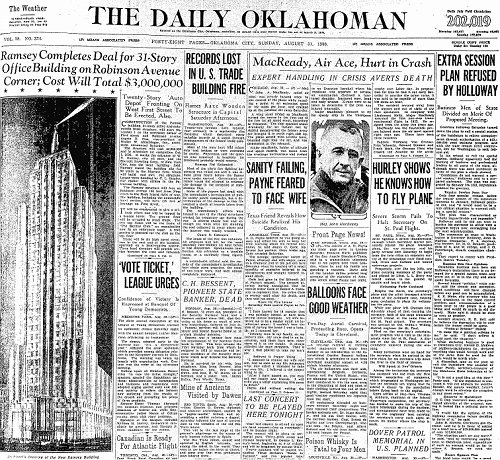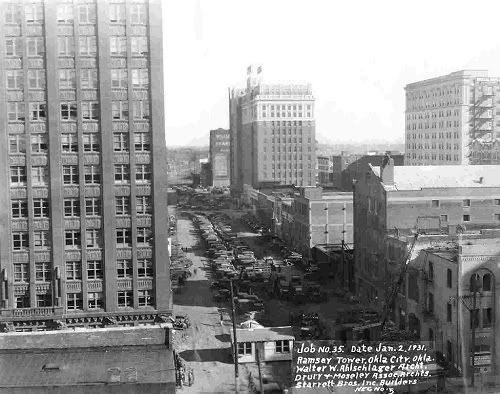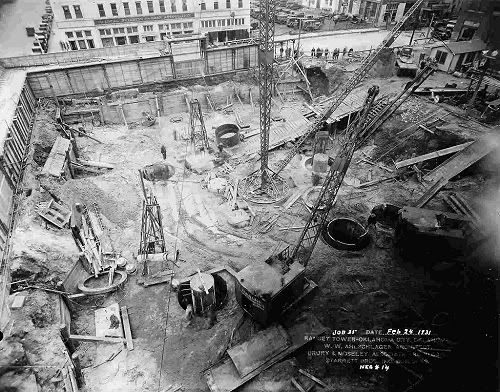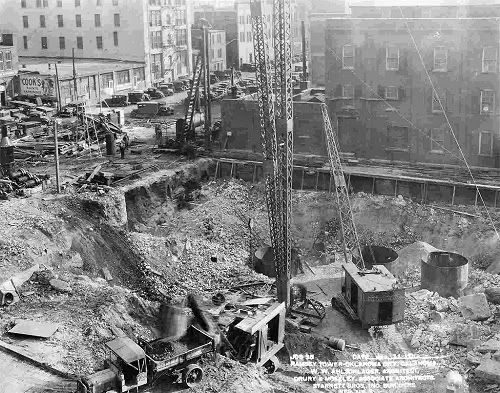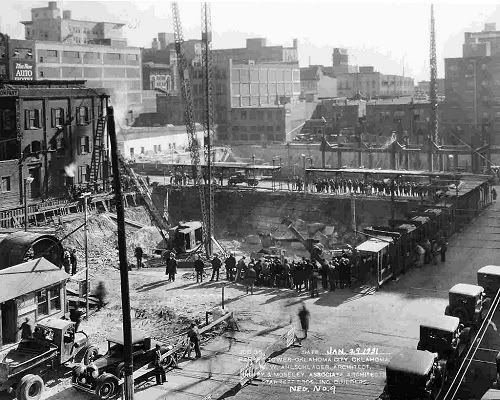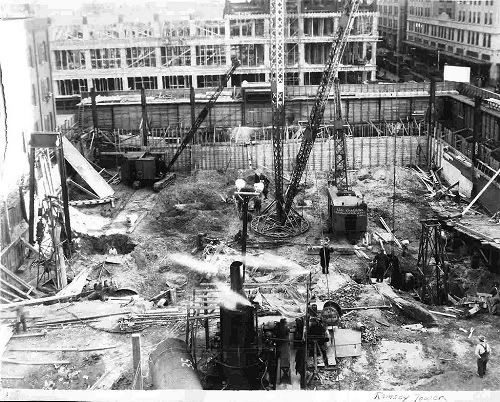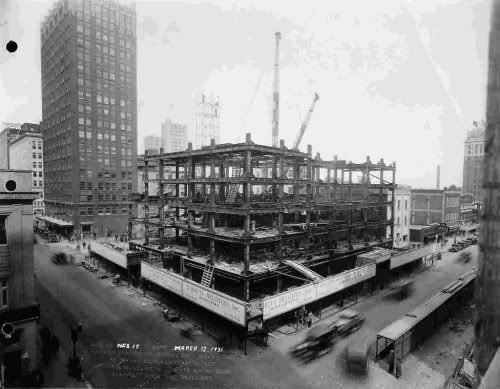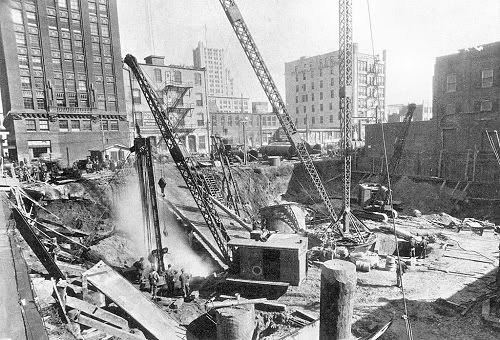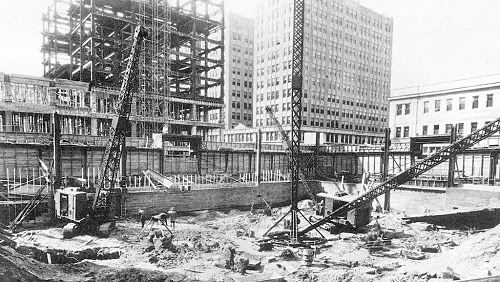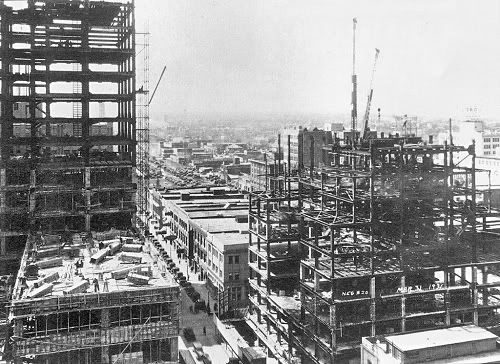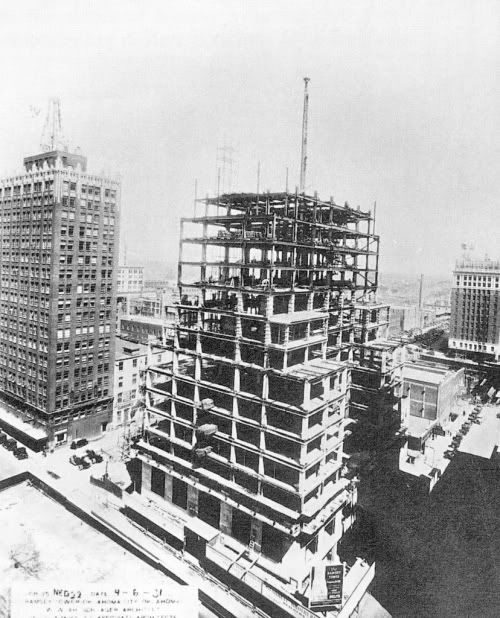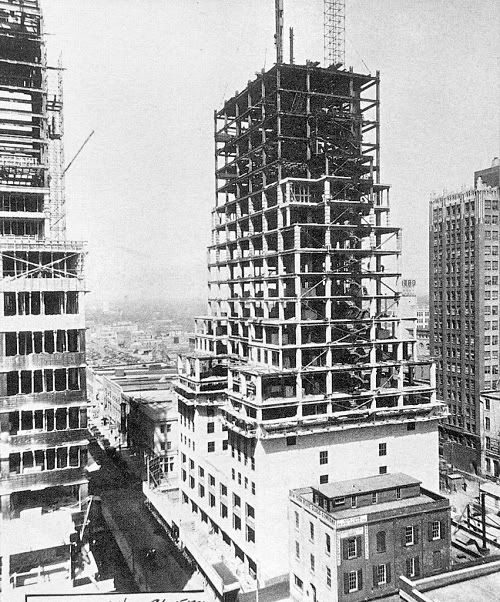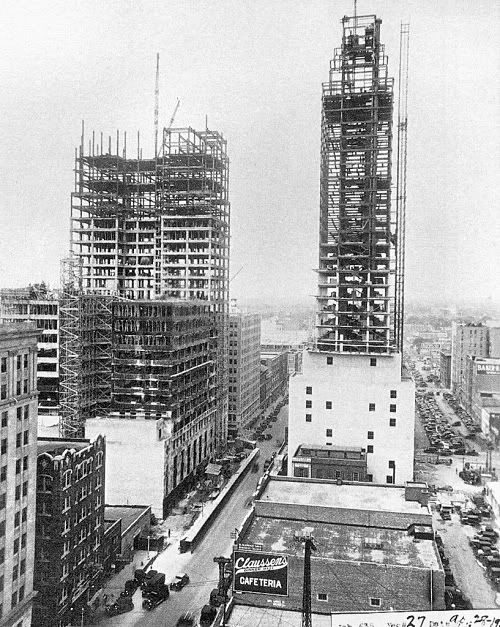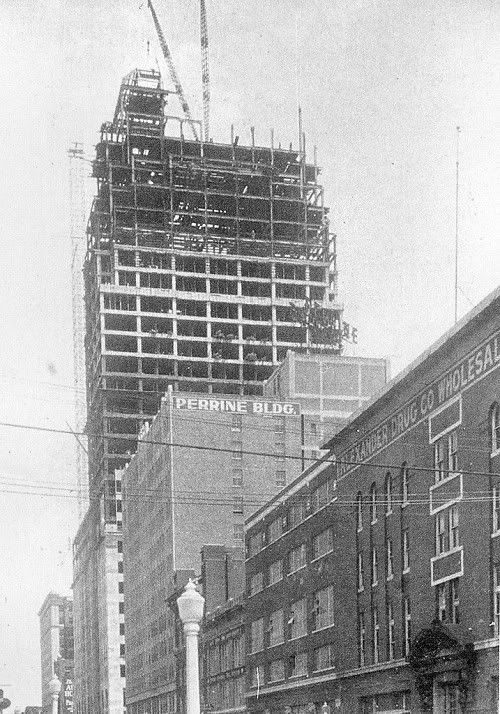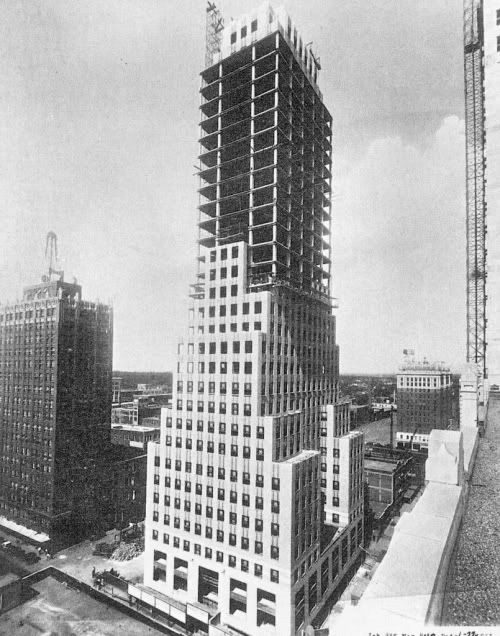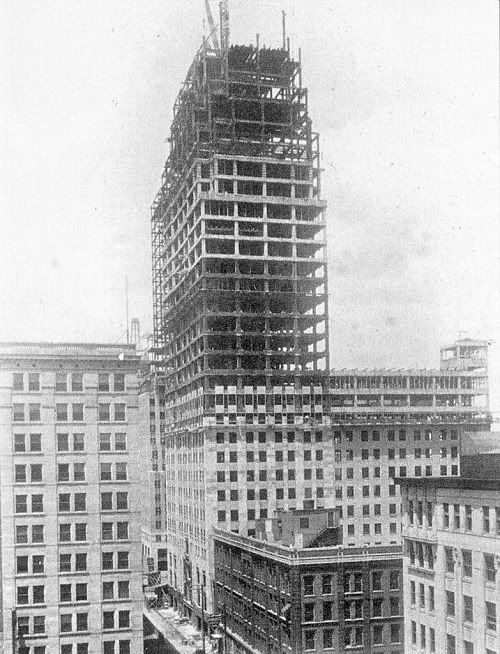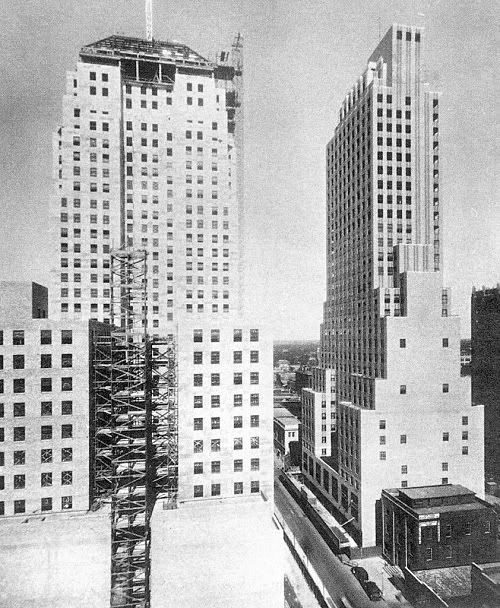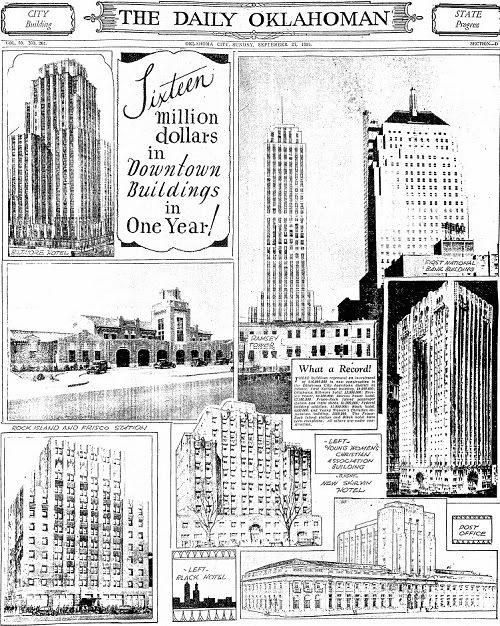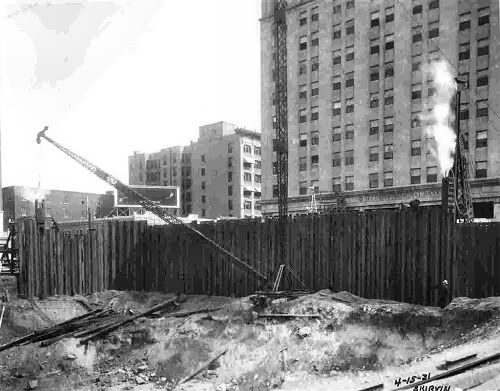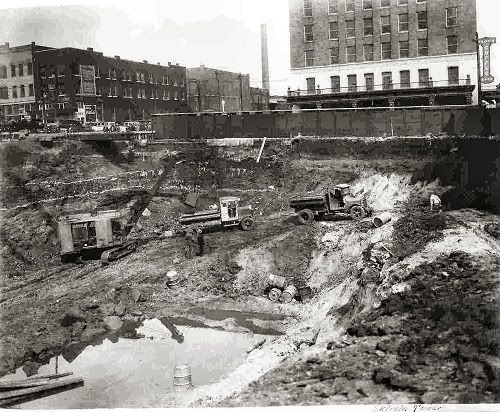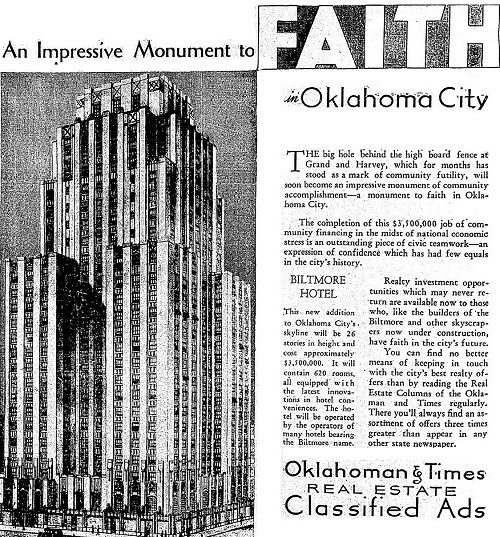Right now, we’re all wrapped up with last week’s approval and next-year’s construction commencement and 2012’s opening of the supertall Devon Tower, which, when done, will place our city in a relatively small handful of United States cities which boast one or more skyscrapers at or above the Tower’s 925′, 54 story level.
But, relatively speaking, we’ve been there and done that before, even if “we’d” have to have used our grand-or-great-grandparents’ eyes to see that happen when it did — in 1931, seventy-seven (77) years ago. Consider this article to be a time machine which takes us back in time to when our ancestors were just as giddy as we are today, to 1931 when Oklahoma City first became a bona fide member of the national “Skyscraper City” club. So, ladies, put on your roaring 20s flapper dresses, and gents, don your stiff-brimmed straw hats … snap your fingers and come on back in time … and you are there!
THE BACKGROUND. Oklahoma City’s downtown building history has not been a constant, steady type of thing. Instead, rather like our oil-based economy, it has come in a clustered series of gushers but it has likewise had significant spans of time which produced nothing but dry holes. The time from 1925 or so through 1931 represents one of Oklahoma City’s most “gusher-i-est” building periods our city has known.
Before 1926, Oklahoma City’s tallest buildings were in the 10–12 story range. A spurt of those buildings popped up between 1910-1912: the Colcord (1910, 12 story), Herskowitz (1910, 12 story), Lee-Huckins Hotel, replacing the 1900 Lee Hotel after destroyed by fire (1910, 10 story), Skirvin Hotel (1911, 10 story), Hales (1910, 10 story), Campbell (1910, 10 story), and Kingkade Hotel (1912, 11 story). Another group with similar dimensions grew from the ground in the early 1920s: Tradesmen’s Bank, City Center today (1921, 11 story), Braniff (1923, 10 story), Medical Arts, now 100 Park Avenue (1923, 12 story), and Harbour-Longmire (1923, 10 story).
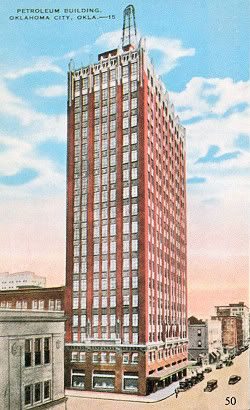 That burst continued into the mid-1920s but finally included one that jumped higher than the rest, the 18-story Petroleum Building which started construction in 1926 and was done in 1927 as shown in the postcard at the right from Vanished Splendor by Hal Ottaway & Jim Edwards. The 16 story Southwestern Bell building (1928) was close behind. The 1923 6-story Cotton Exchange Building was expanded to 10 in that same year. Others built in the 10-13 story range in the last five years of the 1920s were the Skirvin’s expansion to 13-stories in 1928-1930, Perrine, now Robinson Renaissance (1927, 12 story), Roberts Hotel (1927, 10 story), Oklahoma Savings & Loan (1928, 10 story), Commerce Exchange (1928, 10 stories), and Hightower (1929, 10 story). For more about these and other “tall” buildings, see my tall buildings article.
That burst continued into the mid-1920s but finally included one that jumped higher than the rest, the 18-story Petroleum Building which started construction in 1926 and was done in 1927 as shown in the postcard at the right from Vanished Splendor by Hal Ottaway & Jim Edwards. The 16 story Southwestern Bell building (1928) was close behind. The 1923 6-story Cotton Exchange Building was expanded to 10 in that same year. Others built in the 10-13 story range in the last five years of the 1920s were the Skirvin’s expansion to 13-stories in 1928-1930, Perrine, now Robinson Renaissance (1927, 12 story), Roberts Hotel (1927, 10 story), Oklahoma Savings & Loan (1928, 10 story), Commerce Exchange (1928, 10 stories), and Hightower (1929, 10 story). For more about these and other “tall” buildings, see my tall buildings article.
Oklahoman articles boasted of Oklahoma City’s progress in 1929, like this one in January 6, 1929:
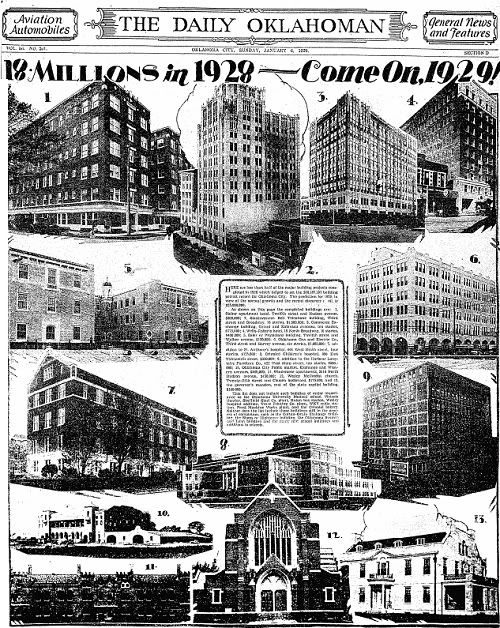
By the end of the 1930s decade, downtown looking east looked like the photo below from Terry L. Griffith’s Images of America: Statehood to 1930. At left, 1928’s Southwestern Bell building is seen, 1927’s Petroleum Building is left of center, and the east/west railroad tracks which would not be removed until after November 30, 1930, are still present. The 1929 Wards building is at the right.
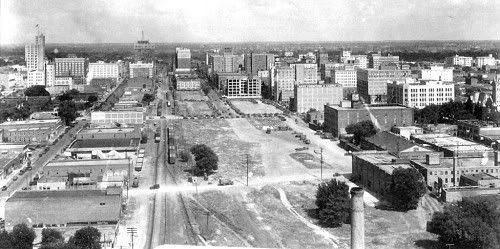
1930-1931: THE GREAT RACE. But, the dimensions would change with the pair of buildings announced in 1930 — those buildings would change Oklahoma City’s perceptions about itself and would thrust our town into the position of being a leading United States skyscraper city in that day. Compare the above photo with the photograph below contained in the Greater Oklahoma City Chamber of Commerce’s archives:
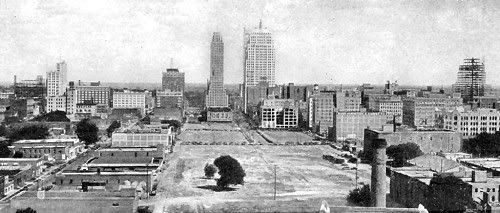
At the far left, the tower of the 1932 Post Office & Federal Court building is under construction and, at right. the structure of the Biltmore which opened in 1933 is progressing. But, in the middle, Oklahoma City has its new skyline.
The first 1930 announcement was about First National. The April 20, 1930, Oklahoman splashed the proposed First National Bank Building’s expectations to all who would read:
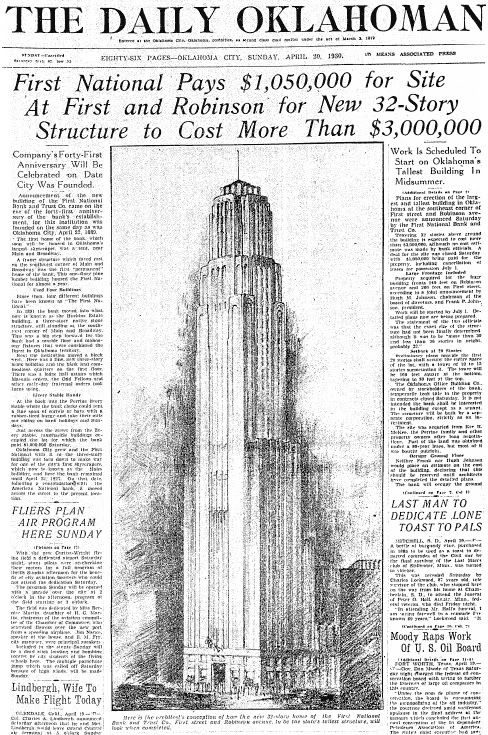
Ramsey Tower headlines came a bit later, on August 31, 1930.
What happened thereafter is called by all Oklahoma City historians as, “The Great Race.”
THE GREAT RACE. Both proposed buildings being located on the east side of Robinson across the street from each other on the street which is now Couch Drive, the race was on as to which would be finished first. Both were completed in 1931 and in remarkable time. (City of Oklahoma City approval, permit, etc., procedures were obviously much less time-consuming and rigorous in 1930 than they are today!) The following photographs trace the race’s progress — most photographs were taken from a Ramsey perspective — Ramsey contractors were apparently more interested in documenting this race than were its 1st National counterparts …
from his Leo Sanders Collection
Ramsey site looking east toward Broadway
Petroleum Building at left; Skirvin in center; Medical Arts right
Foundation work in the Ramsey
Looking South From Ramsey Toward 1st National’s Progress
From Robinson Looking Northeast
Petroleum Building is at the left
The following are credited to Terry L. Griffith’s
Oklahoma City — 1930 to the Millennium
Ramsey Tower won the race, but both then supertall skyscrapers opened their doors in late 1931 at 33 stories apiece.
SKYSCRAPER CITIES IN 1931. This pair of 1931 buildings vaulted Oklahoma City into the ranks of the then-existing skyscraper cities. Using the “Timeline” drawings at www.skyscraperpage.com and based upon the number of storeys, here’s the data for skyscraper cities circa 1931:
First, In Alphabetical Order. The following table shows principal United States cities, arranged alphabetically, buildings measured by stories and not height. It shows the name of the building with the most stories, when built, and use at the time:
| City | 33 or more | Most | Bldg. Name | YearBuilt | Use | |
| 1 | Atlanta | 0 | 21 | Rhodes-Haverty | 1929 | Hotel |
| 2 | Baltimore | 1 | 37 | Bank of America | 1924 | Office |
| 3 | Boston | 0 | 32 | Custom House Tower | 1915 | Hotel |
| 4 | Chicago | 23 | 48 | One North LaSalle | 1930 | Office |
| 5 | Cincinnati | 1 | 49 | Carew Tower | 1931 | Office |
| 6 | Cleveland | 1 | 52 | Terminal Tower | 1930 | Office |
| 7 | Columbus | 1 | 47 | LeVeque Tower | 1927 | Office |
| 8 | Dallas | 0 | 29 | Magnolia Hotel | 1923 | Hotel |
| 9 | Denver | 0 | 24 | AT&T Building | 1929 | Office |
| 10 | Detroit | 6 | 47 | Penobscot Building | 1920 | Office |
| 11 | Ft. Worth | 0 | 23 | Courtyard Ft. Worth | 1929 | Hotel |
| 12 | Houston | 1 | 36 | JP Morgan Building | 1929 | Office |
| 13 | Indianapolis | 0 | 17 | Circle Tower | 1930 | Office |
| 14 | Kansas City | 2 | 35 | K.C. Power & Light | 1931 | Office |
| 15 | Los Angeles | 0 | 28 | LA City Hall | 1927 | Govt. |
| 16 | Memphis | 0 | 29 | Sterick Building | 1930 | Office |
| 17 | Miami | 0 | 28 | Miami-Dade County Courthouse | 1928 | Govt. |
| 18 | Milwaukee | 0 | 25 | Hilton Mil. City Center | 1927 | Hotel |
| 19 | Minneapolis | 0 | 32 | Foshay Tower | 1929 | Office |
| 20 | New Orleans | 0 | 20 | Hibernia Bank Building | 1921 | Office |
| 21 | New York | 61 | 102 | Empire State Building | 1931 | Office |
| 22 | Oklahoma City | 2 | 33 | 1st National & Ramsey Tower | 1931 | Office |
| 23 | Philadelphia | 2 | 33 | Drake Hotel | 1929 | Hotel |
| 24 | Phoenix | 0 | 16 | Westward Ho | 1927 | Hotel |
| 25 | Pittsburgh | 2 | 40 | Grant Building | 1928 | Office |
| 26 | Portland | 0 | 16 | Public Service Building | 1927 | Office |
| 27 | Providence | 0 | 26 | Bank of America | 1927 | Office |
| 28 | Sacramento | 0 | 15 | Citizen Hotel | 1925 | Hotel |
| 29 | Salt Lake City | 0 | 16 | Deseret Building | 1912 | Office |
| 30 | San Deigo | 0 | 15 | El Cortez Hotel | 1927 | Hotel |
| 30 | San Diego | 0 | 15 | El Cortez Hotel | 1927 | Hotel |
| 31 | San Francisco | 0 | 31 | Russ Building | 1927 | Office |
| 32 | Seattle | 1 | 38 | Smith Tower | 1914 | Office |
| 33 | St. Louis | 0 | 28 | SW Bell Building | 1926 | Office |
| 34 | St. Paul | 0 | 32 | 1st National Bank | 1930 | Office |
| 35 | Tulsa | 0 | 22 | 320 S. Boston | 1929 | Office |
Second, In Order of Story Rank. Sorting the above information by cities having buildings at least 33 stories (not height), Oklahoma City fared pretty well in 1931, a tie with Philadelphia for 12th in the list — heady stuff for the young pup of a city that Oklahoma City was only 42 years of age.
| City | 33 or more | Most | Bldg. Name | YearBuilt | Use | |
| 1 | New York | 61 | 102 | Empire State Building | 1931 | Office |
| 2 | Cleveland | 1 | 52 | Terminal Tower | 1930 | Office |
| 3 | Cincinnati | 1 | 49 | Carew Tower | 1931 | Office |
| 4 | Chicago | 23 | 48 | One North LaSalle | 1930 | Office |
| 5 | Detroit | 6 | 47 | Penobscot Building | 1920 | Office |
| 6 | Columbus | 1 | 47 | LeVeque Tower | 1927 | Office |
| 7 | Pittsburgh | 2 | 40 | Grant Building | 1928 | Office |
| 8 | Seattle | 1 | 38 | Smith Tower | 1914 | Office |
| 9 | Baltimore | 1 | 37 | Bank of America | 1924 | Office |
| 10 | Houston | 1 | 36 | JP Morgan Building | 1929 | Office |
| 11 | Kansas City | 2 | 35 | K.C. Power & Light | 1931 | Office |
| 12 | Oklahoma City | 2 | 33 | 1st National & Ramsey Tower | 1931 | Office |
| 12 | Philadelphia | 2 | 33 | Drake Hotel | 1929 | Hotel |
| 14 | Boston | 0 | 32 | Custom House Tower | 1915 | Hotel |
| 15 | Minneapolis | 0 | 32 | Foshay Tower | 1929 | Office |
| 16 | St. Paul | 0 | 32 | 1st National Bank | 1930 | Office |
| 17 | San Francisco | 0 | 31 | Russ Building | 1927 | Office |
| 18 | Dallas | 0 | 29 | Magnolia Hotel | 1923 | Hotel |
| 19 | Memphis | 0 | 29 | Sterick Building | 1930 | Office |
| 20 | Los Angeles | 0 | 28 | LA City Hall | 1927 | Govt. |
| 21 | Miami | 0 | 28 | Miami-Dade County Courthouse | 1928 | Govt. |
| 22 | St. Louis | 0 | 28 | SW Bell Building | 1926 | Office |
| 23 | Providence | 0 | 26 | Bank of America | 1927 | Office |
| 24 | Milwaukee | 0 | 25 | Hilton Mil. City Center | 1927 | Hotel |
| 25 | Denver | 0 | 24 | AT&T Building | 1929 | Office |
| 26 | Ft. Worth | 0 | 23 | Courtyard Ft. Worth | 1929 | Hotel |
| 27 | Tulsa | 0 | 22 | 320 S. Boston | 1929 | Office |
| 28 | Atlanta | 0 | 21 | Rhodes-Haverty | 1929 | Hotel |
| 29 | New Orleans | 0 | 20 | Hibernia Bank Building | 1921 | Office |
| 30 | Indianapolis | 0 | 17 | Circle Tower | 1930 | Office |
| 31 | Phoenix | 0 | 16 | Westward Ho | 1927 | Hotel |
| 32 | Portland | 0 | 16 | Public Service Building | 1927 | Office |
| 33 | Salt Lake City | 0 | 16 | Deseret Building | 1912 | Office |
| 34 | Sacramento | 0 | 15 | Citizen Hotel | 1925 | Hotel |
| 35 | San Diego | 0 | 15 | El Cortez Hotel | 1927 | Hotel |
THE BOOM ENDS. Well into 1931, optimistic articles and headlines spoke of how Oklahoma City was avoiding serious impact of the Great Depression which followed Wall Street’s month long October 1929 crash.
The buildings shown in the above optimistic article are, clockwise from the upper left corner, the Biltmore Hotel, Ramsey Tower, 1st National, Skirvin Tower, Post Office & Federal Court expansion, YWCA, Black Hotel, and Union Station. Notice the planned design of the Skirvin Tower at the right which Bill Skirvin intended to be a 26 story building.
The Great Depression was slow to reach Oklahoma City, but it did. The buildings shown in the above article, already started, would get done, sort of. Excavation started for the planned 26-story Skirvin Tower in 1931, as shown below:
But, when the economy turning sour, Bill Skirvin delayed construction and eventually scaled back the plan. The final 14 story structure was fully opened in 1937. Although some doubt existed that the 26-story Biltmore Hotel would get done, the Oklahoman expressed “Faith” that it would . . .
. . . and of course it did and opened its doors in 1932. As for the others appearing in the above Oklahoman article, they got done, too, plus another, the 1930 10-story Midwest Building which was the home of the Midwest Theater.
But, aside from the WPA funded/assisted Civic Center project, including 1937’s 11-story Oklahoma County Courthouse, the “pause” button was pushed firmly down on any new significant downtown Oklahoma City buildings for more than 20 years until the next “mini-spurt” would occur in the mid-1950s — Fidelity Bank, now Park Harvey (1956, 17 stories) and a handful of other 10 to 15 story buildings (Southwestern Bell, now DEQ, 1957 at 10 stories; 1st National addition, 1957, at 14 stories; Globe Life, 1957 at 15 stories) would be constructed during that time — all good to have, but really nothing to get spastic about in your letters to your relatives in Chicago or Los Angeles or any other big city. By the time the 1950s rolled around, Oklahoma City had drifted far back in the skyscraper pack, as far as really tall buildings were concerned. Only in 1971, 40 years after the “Great Race,” would a taller-than-33 story building be built in Oklahoma City, Liberty Tower at 36 stories.
But, all that said, in 1931, Oklahoma City was riding high, at least as high, if not more (relatively speaking), than we are today. So, get your shovels and hard hats ready and, next year, start gawking at that thing which will come out of the ground, just like your grandfathers and grandmothers did 77 years ago! With them, you will share their joy and awe and be one with them. It’s about Damn Doug Dawg time!

